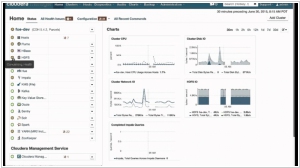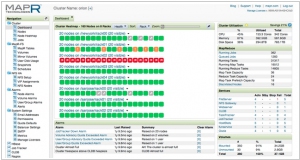Cloudera vs MapR
March 10, 2025 | Author: Michael Stromann
12★
Cloudera helps you become information-driven by leveraging the best of the open source community with the enterprise capabilities you need to succeed with Apache Hadoop in your organization. Designed specifically for mission-critical environments, Cloudera Enterprise includes CDH, the world’s most popular open source Hadoop-based platform, as well as advanced system management and data management tools plus dedicated support and community advocacy from our world-class team of Hadoop developers and experts. Cloudera is your partner on the path to big data.
5★
The MapR Distribution for Apache Hadoop provides organizations with an enterprise-grade distributed data platform to reliably store and process big data. MapR packages a broad set of Apache open source ecosystem projects enabling batch, interactive, or real-time applications. The data platform and the projects are all tied together through an advanced management console to monitor and manage the entire system.
See also:
Top 10 Big Data platforms
Top 10 Big Data platforms
Cloudera and MapR, in their infinite wisdom, both decided that the world desperately needed vast, sprawling data platforms capable of wrangling petabytes of information while looking stylish in enterprise boardrooms. They embraced Hadoop like an overenthusiastic puppy, promising real-time analytics, robust security and the kind of scalable architecture that would make a spaceship engineer weep with joy. Companies flocked to them, lured by dreams of data lakes, machine learning and IoT magic, all while hoping their clusters wouldn’t catch fire under pressure.
Cloudera, the elder of the two, emerged in 2008 in the USA, determined to make open-source big data cool before anyone else had quite figured out what big data even was. It danced gracefully through cloud and on-premises solutions, eventually absorbing Hortonworks in a dramatic corporate fusion that confused everyone for a bit but resulted in even more analytics power. Its obsession with hybrid cloud environments and AI-driven insights gave it a distinctly futuristic air, as if it were preparing for a future where spreadsheets would demand their own civil rights.
MapR, arriving fashionably late in 2009, had a more rebellious streak, deciding that standard Hadoop storage wasn’t quite good enough and inventing its own file system instead. This proprietary wizardry allowed it to do things other platforms couldn't, like pretending to be a normal NFS server while secretly managing colossal amounts of streaming data. It was the go-to choice for organizations obsessed with real-time analytics, edge computing and possibly world domination. In 2019, it was scooped up by HPE, proving once and for all that even the most independent data platforms eventually get eaten by a larger fish.
See also: Top 10 Big Data platforms
Cloudera, the elder of the two, emerged in 2008 in the USA, determined to make open-source big data cool before anyone else had quite figured out what big data even was. It danced gracefully through cloud and on-premises solutions, eventually absorbing Hortonworks in a dramatic corporate fusion that confused everyone for a bit but resulted in even more analytics power. Its obsession with hybrid cloud environments and AI-driven insights gave it a distinctly futuristic air, as if it were preparing for a future where spreadsheets would demand their own civil rights.
MapR, arriving fashionably late in 2009, had a more rebellious streak, deciding that standard Hadoop storage wasn’t quite good enough and inventing its own file system instead. This proprietary wizardry allowed it to do things other platforms couldn't, like pretending to be a normal NFS server while secretly managing colossal amounts of streaming data. It was the go-to choice for organizations obsessed with real-time analytics, edge computing and possibly world domination. In 2019, it was scooped up by HPE, proving once and for all that even the most independent data platforms eventually get eaten by a larger fish.
See also: Top 10 Big Data platforms





